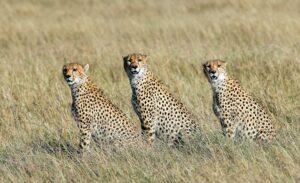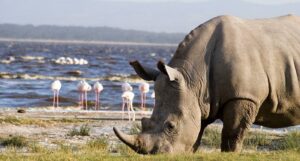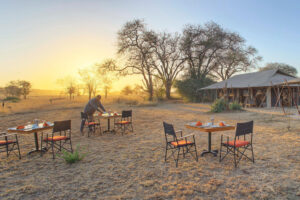Combining a safari in Kenya and Tanzania
Combining a safari in Kenya and Tanzania puts you close to an incredible variety of wildlife unequaled by any other location.
In East Africa are two popular safari countries, Kenya and Tanzania, known for some of the best wildlife encounters.
Over a million ungulates migrate between Kenya and Tanzania as part of one of the world’s largest and last remaining animal migrations in search of greener, more fertile pastures. In addition to the incredible prospects for wildlife viewing, we will explore a few negatives to give you a clearer understanding of the benefits and drawbacks of going on this ideal Kenya and Tanzania Safari.

BENEFITS OF A SAFARI IN KENYA AND TANZANIA
The best and most diverse wildlife safari Viewing possibilities
Combining a safari in Tanzania and Kenya has the benefit of seeing more wildlife. You are sure to view and interact with the Big Five animals if you take the combined safari.
The Leopard and Rhino are the two most challenging of the Big Five.
Some of Kenya’s conservancies and national parks make it simple to spot rhinos. On wildlife safaris in Solio, Ol Pejeta, and Lake Nakuru, people frequently see white and black rhinos. Some top places to visit to spot the Leopard are the Samburu, Tsavo, and Masai Mara in Kenya and Serengeti, Ruaha and Selous in Tanzania. Due to its solitary nature, the Black Rhino is harder to locate while on a safari. The Masai Mara, Serengeti, and Ngorongoro Crater are other places where you can view the Black Rhino.

Assurance of the Migration of the Wildebeest and the Zebra
The passage of the herds between Kenya and Tanzania is the focal point of the Wildebeest Migration. Between July and October, Migration occurs in Kenya. The Migration may occasionally start early and end earlier or later with various intensities because the overall amount of time spent in Kenya is not specific to any time frame.
The Migration is in Tanzania for the remaining months of the year. The Wildebeest herds colonize the Ngorongoro Conservation Area from December to March. They go around 160 kilometers east and south, respectively, toward the Ngorongoro Crater and the Southern Serengeti.
The herds move steadily northward toward Kenya between March and June. If you combine a safari in Kenya and Tanzania, you will see the herds in Masai Mara Kenya, the Serengeti, or the Ngorongoro Conservation Area near Lake Ndutu.
The Northern Serengeti, Central Serengeti, Southern Serengeti, or Lake Ndutu in the Ngorongoro Conservation Area are the primary concentration locations of the migration corridor, and you can choose an accommodation choice that is most convenient to the herds there.

Experience with Various Landscapes
Kenya offers a wider variety of landscapes than Northern Tanzania. The landscape is different from one park or wildlife reserve to the next. While the Masai Mara in Kenya is more savanna-like, with riverine vegetation and acacias dotting the terrain, Samburu is a more arid scrub area in the north.
The vast Savannah of Amboseli, located further south in Kenya, is framed by Africa’s tallest peak, Kilimanjaro. The Aberdare ranges in Kenya are a section of a mountainous region with thick vegetation and waterfalls.
Scenic Wild Country
Tarangire, Ngorongoro, lake Manyara, and Serengeti are parks in northern Tanzania.
The Serengeti and the Masai Mara have comparable altitudes, geography, and eco-region.
A collapsed caldera with a remarkable richness of species is the Ngorongoro crater.
As part of the adventure-filled drive into the crater, the Jeeps gently descend the incline towards the caldera.
At sunrise and dusk, the Ngorongoro Crater is breathtaking from the lodges and camps on the crater rim.
The Tarangire is lower and drier, with many more elephants and baobab trees.
The Tsavo West National Park in Kenya, to the south of Kenya, is where you may see baobab trees.
The Tsavo East and West in Kenya are also hosts to the massive density of Elephants.

Cost of Air Travel to East Africa
Traveling by air to Africa can be very expensive. Compared to flights from South America, America, and Australia, which can cost you several thousand dollars, flights from Europe to Africa are less expensive.
This combined safari makes it more cost-effective to take a return flight to Nairobi or Kilimanjaro and a safari that includes both Tanzania and Kenya than to take two separate flights and two separate safaris if visiting Africa is on your bucket list. You may fly to Nairobi’s Jomo Kenyatta International Airport to begin your safari in Kenya, travel to Tanzania, and return to Nairobi to finish the safari in time for your journey home. Taking a single trip to Kenya and Tanzania implies that you have saved time preparing for the journey in two distinct nations. The trip from Kenya to Tanzania is straightforward, and if you’re coming from Amboseli or Arusha, you can cross the border at Namanga. Traveling from the Mara to Serengeti, you can cross the border at Isebania.

A KENYA-TANZANIA SAFARI’S DISADVANTAGES
More days on safari are required.
There are drawbacks to a safari that includes both Kenya and Tanzania.
There is a minimum number of days you would need to complete the safari comfortably because this would mean you are visiting more parks.
Planning for at least eight days is recommended, but you can extend your trip to enjoy the safari at a leisurely pace and see more national parks with a broader range of experiences.
You’ll have plenty of time to explore these enormous areas and have more successful wildlife viewing experiences if you spend more days in the more extensive parks. It’s also advisable during the wildebeest calving season in the Serengeti’s Ngorongoro Conservation Area.
It would be best to spend at least two days in the Lake Ndutu region and another three days in Serengeti, as these are two distinct national parks.
The Safari is Expensive
The overall expense of the safari is one of the main drawbacks of combining the Kenya and Tanzania safari.
The safari’s usage of two different transport vehicles significantly impacts this.
In Tanzania, only cars registered in Tanzania may enter the parks; in Kenya, only safari vehicles registered in Kenya may enter the national parks and reserves. The cross-border transfers between Kenya and Tanzania result in additional transportation and guide charges.
A safari vehicle must leave Arusha the day before to travel to Isebania. This western border crossing is closest to Masai Mara, with the safari guide from Masai Mara leaving you off at the border will require an additional day to travel back to Nairobi.
When combining the Kenya and Tanzania safaris, the additional transit logistics will increase the overall cost of the safari.

Greater Travel Distance and Time Between the Cross-Border Parks
Cross-border transfers from Amboseli to Tarangire or Lake Manyara can occasionally take a long time and be laborious.
The typical border crossing process, including immigration and clearance, lasts roughly an hour. This cross-border transfer adds up to an average of 6 hours of non-game viewing drive time combined with the drive from the border.
Traveling to Serengeti in Tanzania and the drive from Masai Mara to Serengeti take roughly 6 hours.
For a fee, it is possible to fly from the Serengeti to the Masai Mara, saving valuable time spent watching animals.
Select a safari package that includes at least three nights in the Serengeti and Masai Mara to compensate for the extra day lost.
As an alternative, think about staying west or North of the Serengeti before driving into the central Serengeti.
Please don’t hesitate to contact us if you have any questions or need help planning a combined Kenya and Tanzania safari.
